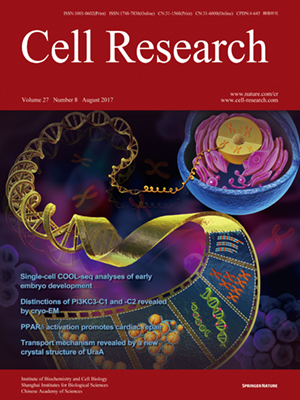
Volume 27, No 8, Aug 2017
ISSN: 1001-0602
EISSN: 1748-7838 2018
impact factor 17.848*
(Clarivate Analytics, 2019)
Volume 27 Issue 8, August 2017: 1002-1019 | Open Access
ORIGINAL ARTICLES
Live cell screening platform identifies PPARδ as a regulator of cardiomyocyte proliferation and cardiac repair
Ajit Magadum1,2,*, Yishu Ding3,*, Lan He3, Teayoun Kim3, Mohankrishna Dalvoy Vasudevarao4, Qinqiang Long3,5, Kevin Yang3, Nadeera Wickramasinghe6, Harsha V Renikunta1, Nicole Dubois6, Gilbert Weidinger4, Qinglin Yang3,5 and Felix B Engel1,7,8
1Department of Cardiac Development and Remodelling, Max-Planck-Institute for Heart and Lung Research, Parkstrasse 1, Bad Nauheim 61231, Germany
2Department of Cardiology, Icahn School of Medicine at Mount Sinai Hospital, One Gustave L. Levy Place, Box 1030, New York, NY 10029, USA
3Department of Nutrition Sciences, University of Alabama at Birmingham, 1675 University Blvd, Birmingham, AL 35294-3360, USA
4Institute of Biochemistry and Molecular Biology, Ulm University, Albert-Einstein-Allee 11, Ulm 89081, Germany
5Department of Internal Medicine, Tongji Hospital, Huazhong Technology University, Wuhan, China
6Department for Cell, Developmental and Regenerative Biology, Icahn School of Medicine at Mount Sinai, 1470 Madison Avenue, Box 1040, New York, NY 10029, USA
7Department of Nephropathology, Experimental Renal and Cardiovascular Research, Institute of Pathology, Friedrich-Alexander-Universität Erlangen-Nürnberg, Schwabachanlage 12, Erlangen 91054, Germany
8Muscle Research Center Erlangen (MURCE)
Correspondence: Felix B Engel, Tel: +49-0-9131-85 25699 E-mail: felix.engel@uk-erlangen.de; Qinglin Yang,(qyang@uab.edu)
Zebrafish can efficiently regenerate their heart through cardiomyocyte proliferation. In contrast, mammalian cardiomyocytes stop proliferating shortly after birth, limiting the regenerative capacity of the postnatal mammalian heart. Therefore, if the endogenous potential of postnatal cardiomyocyte proliferation could be enhanced, it could offer a promising future therapy for heart failure patients. Here, we set out to systematically identify small molecules triggering postnatal cardiomyocyte proliferation. By screening chemical compound libraries utilizing a Fucci-based system for assessing cell cycle stages, we identified carbacyclin as an inducer of postnatal cardiomyocyte proliferation. In vitro, carbacyclin induced proliferation of neonatal and adult mononuclear rat cardiomyocytes via a peroxisome proliferator-activated receptor δ (PPARδ)/PDK1/p308Akt/GSK3β/β-catenin pathway. Inhibition of PPARδ reduced cardiomyocyte proliferation during zebrafish heart regeneration. Notably, inducible cardiomyocyte-specific overexpression of constitutively active PPARδ as well as treatment with PPARδ agonist after myocardial infarction in mice induced cell cycle progression in cardiomyocytes, reduced scarring, and improved cardiac function. Collectively, we established a cardiomyocyte proliferation screening system and present a new drugable target with promise for the treatment of cardiac pathologies caused by cardiomyocyte loss.
10.1038/cr.2017.84
FULL TEXT | PDF
Browse 2222


